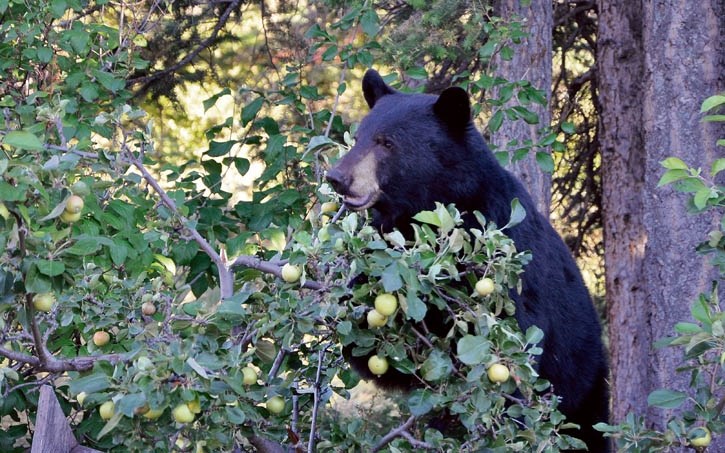Approximately 20 crabapples trees have been cut down in the Banff townsite this fall as part of a voluntary program to prevent opportunistic bears heading into town in search of food.
Officials say crabapple and other fruit trees have long been luring bears into the national park townsite, noting bear 148, a four-and-a-half-year-old female grizzly bear, was feasting on crabapples and other fruit trees earlier this fall.
“We’re certainly impressed with the number of residents who have recognized this to be a critical issue,” said Steve Michel, a human-wildlife conflict specialist for Banff National Park.
“It’s a really good first step and hopefully in the years ahead we’ll be able to make further progress and have more fruit trees removed.”
Parks Canada has provided $15,000 and the Town of Banff has kicked in $6,000 for the program.
Property owners interested in removing their crabapple trees applied to the Town of Banff to cut them down. Parks Canada has hired a contractor to replace the trees with native non-fruit bearing trees in the spring.
Council still has an option to consider legislation in the future to ensure crabapple and other fruit trees are at least harvested each year, if not removed and replaced, should this continue to be a problem.
The Whyte Museum of the Canadian Rockies is one of several properties to take advantage of the incentive program, removing a crabapple tree on its property near the library.
“I’d sooner see trees go down than a bear,” said Brett Oland, CEO of the Whyte Museum.
“This was the right thing to do and it was about being bear aware and making sure the animals aren’t coming into town and eating the fruit,” he added.
“It turns out to be quite a pain to get up there every fall and make sure all the apples are off the tree. It’s right out there in the open and it’s where are a lot of people are too.”
Crabapple trees and other fruit trees are scattered throughout town, including at The Banff Centre and various residential neighbourhoods. Parks Canada removed fruit trees from the grounds of the park administration building and superintendent’s residence in 2013.
Last year, a female black bear known as 1401 and grizzly bear 148 – the daughter of 22-year-old famed female grizzly 64 – both took advantage of ripening fruit trees inside the Banff townsite.
Bear 1401 had to be euthanized after a capturing procedure accidentally went wrong, leaving her paralyzed when a tranquiller dart hit her spine. Despite efforts, she did not recover and wildlife experts were forced to put her down.
Parks Canada was trying to relocate her out of town before the busy 2014 September Labour Day long weekend, planning to mount an extensive aversive conditioning program when she inevitably came back.
At one point, the bruin was up a tree mere feet from a balcony at Whiskey Creek condos where children were playing. The bear also made it onto the roof of one of the three-storey buildings there. She also climbed a tree near a bus stop on Banff Avenue opposite the Fox hotel.
In 2008, black bear 133 was put down after she continually got into garbage and fruit trees.
This fall, bear 148 has again been in town looking for fruit in trees. On Oct. 6, she was making the rounds on the south side of the Bow River, including Glen Avenue, Spray Avenue and Park Avenue.
A week or so before that, she was on Cougar Street eating fruit from a chokecherry tree.
“These types of situations are obviously very concerning to us,” said Michel. “It shows how powerful an attractant fruit trees are to bears.”
Chad Townsend, the Town of Banff’s environmental coordinator, said the municipality sent letters to 39 properties to let them know about the new fruit tree removal incentive program.
He said he believes part of the uptake on the program can be attributed to the fact there’s no cost to property owners, but also because of the media stories on the situation in Canmore this year where many bears were relocated after getting into crabapple trees.
“We really had no idea exactly how many people would go for this. I would say we’ve been pleasantly surprised,” said Townsend. “Most people have been really cooperative. Some people stepped forward and said ‘I ‘m not on the list, but I have a crabapple tree.’
“I think it was primarily people who recognize the need to address this in their yard and don’t want to be part of the bear attraction.”
Michel said there are still areas of concern in town, noting crabapple trees at The Banff Centre and residential neighbourboods close to the Sulphur Mountain wildlife corridor, including Middle Springs and Park Avenue.
“Certainly those are some areas of town that are still concerning to us,” he said.




